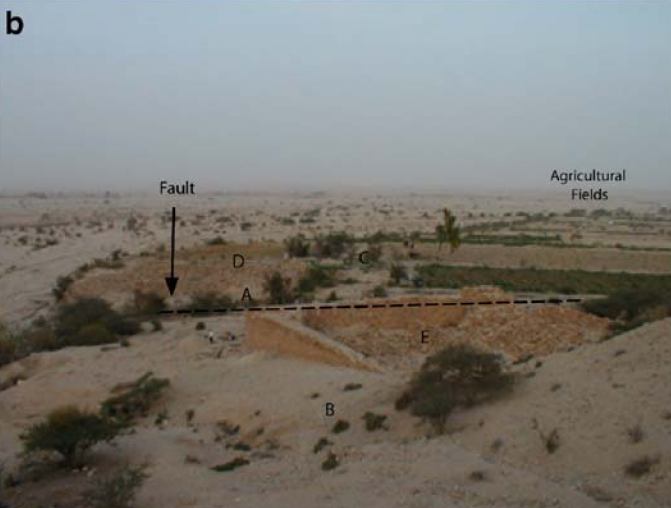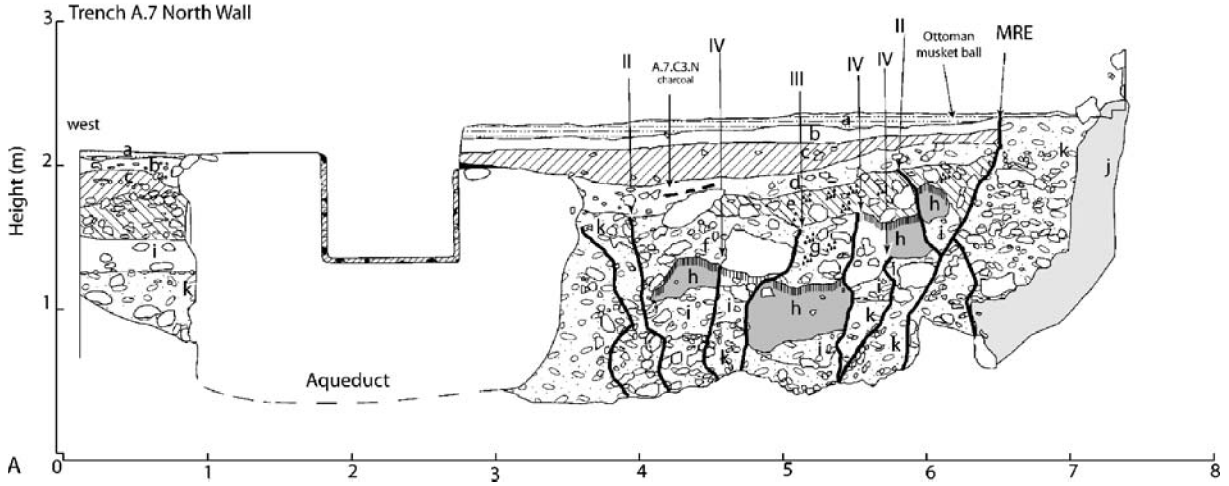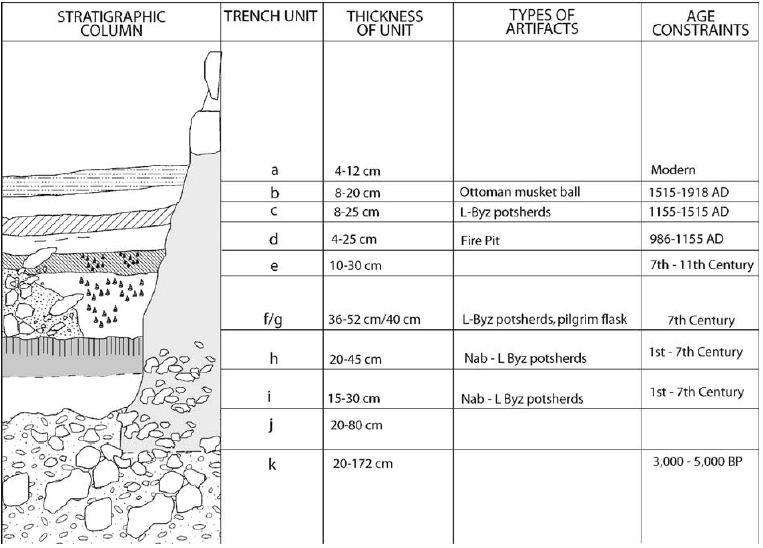Qasr Tilah
 Photo of ruptured birkeh wall
Photo of ruptured birkeh wallFault and fault motion annotated in pink
Photo by Jefferson Williams
- Fig. 1 - Location Map and
Geologic Map from Haynes et. al. (2006)

 Fig. 1
Fig. 1
- Regional tectonic map of the Dead Sea transform fault system
- Schematic geologic map of the Wadi Araba valley showing study location (Modified after Garfunkel et al.1981)
- Schematic Quaternary geologic map of the study area (Modified after Zhang 1998). WAF is line trending N8°E. Qasr Tilah structures in SE corner of map as shaded polygons
- Ancient agricultural fields represented as grid on Qf2 surface
- Dead Sea Highway represented as double line in northern half of map
- Tdc – Tertiary Dana Conglomerate bedrock units
- Ql –Quaternary Lisan formation
- Qf1 – oldest Quaternary alluvial-fan
- Qf2 – Quaternary alluvial-fan overlying Qf1
- Qf3 – mostrecent Quaternary alluvial-fan deposit
Haynes et. al. (2006) - Location Map from
from Meyers et al (1997)

 Wadi el-Hasa
Wadi el-Hasa
Map of Wadi el-Hasa Archaeological Survey territory
(Courtesy B. MacDonald
Meyers et al (1997) - Fig. 5 - Map of Qasir el Telah
area from Galli and Galadini (2001)

 Fig. 5
Fig. 5
Map of Qasir el Telah area. The AJF crosses and displaces the northwestern corner of the Roman-Nabatean reservoir. Hatched areas represent pre-Quaternary basement (modified after Galli, 1999).
Galli and Galadini (2001)
- Fig. 1 - Location Map and
Geologic Map from Haynes et. al. (2006)

 Fig. 1
Fig. 1
- Regional tectonic map of the Dead Sea transform fault system
- Schematic geologic map of the Wadi Araba valley showing study location (Modified after Garfunkel et al.1981)
- Schematic Quaternary geologic map of the study area (Modified after Zhang 1998). WAF is line trending N8°E. Qasr Tilah structures in SE corner of map as shaded polygons
- Ancient agricultural fields represented as grid on Qf2 surface
- Dead Sea Highway represented as double line in northern half of map
- Tdc – Tertiary Dana Conglomerate bedrock units
- Ql –Quaternary Lisan formation
- Qf1 – oldest Quaternary alluvial-fan
- Qf2 – Quaternary alluvial-fan overlying Qf1
- Qf3 – mostrecent Quaternary alluvial-fan deposit
Haynes et. al. (2006) - Location Map from
from Meyers et al (1997)

 Wadi el-Hasa
Wadi el-Hasa
Map of Wadi el-Hasa Archaeological Survey territory
(Courtesy B. MacDonald
Meyers et al (1997) - Fig. 5 - Map of Qasir el Telah
area from Galli and Galadini (2001)

 Fig. 5
Fig. 5
Map of Qasir el Telah area. The AJF crosses and displaces the northwestern corner of the Roman-Nabatean reservoir. Hatched areas represent pre-Quaternary basement (modified after Galli, 1999).
Galli and Galadini (2001)
- Qasr Tilah in Google Earth
- Fig. 2b - Photo of study area
from Haynes et. al. (2006)

 Fig. 2b
Fig. 2b
Birdseye view of the study area to west.
- Area A is located on west side of the birkeh
- Area B (influent aqueduct) is in the foreground
- Area C is the west trending aqueduct
- Area D is the Roman period for
- Area E is the interior of the aqueduct
Ancient and modern agricultural fields are in the background.
Haynes et. al. (2006)
- Fig. 2a - Site Map from
Haynes et. al. (2006)

 Fig. 2a
Fig. 2a
Site map of Qasr Tilah water structure (birkeh) and aqueduct with archaeological trenches of area A. WAF is the line trending N8°E. Trench A.7 encompasses offset aqueduct.
Haynes et. al. (2006) - Fig. 3 - Plan of ruptured
birkeh wall from Haynes et. al. (2006)

 Fig. 3
Fig. 3
- NW-trending aqueduct and settling pool from Total Station survey data. Unexposed sections of the aqueduct are unexcavated trench boundaries (balks). The junction of the NW aqueduct with the west trending aqueduct is located at the lower left corner. The dashed line indicates approximate location of the west birkeh wall.
- Offset of aqueduct in Trench A.7 and vicinity.
- X: east aqueduct wall
- Y: aqueduct floor
- Z: west aqueduct wall
Offset measurements taken in the field and digitally from five locations along the aqueduct walls and floor along the trend of the fault (N8°E).
Haynes et. al. (2006)
- Fig. 2a - Site Map from
Haynes et. al. (2006)

 Fig. 2a
Fig. 2a
Site map of Qasr Tilah water structure (birkeh) and aqueduct with archaeological trenches of area A. WAF is the line trending N8°E. Trench A.7 encompasses offset aqueduct.
Haynes et. al. (2006) - Fig. 3 - Plan of ruptured
birkeh wall from Haynes et. al. (2006)

 Fig. 3
Fig. 3
- NW-trending aqueduct and settling pool from Total Station survey data. Unexposed sections of the aqueduct are unexcavated trench boundaries (balks). The junction of the NW aqueduct with the west trending aqueduct is located at the lower left corner. The dashed line indicates approximate location of the west birkeh wall.
- Offset of aqueduct in Trench A.7 and vicinity.
- X: east aqueduct wall
- Y: aqueduct floor
- Z: west aqueduct wall
Offset measurements taken in the field and digitally from five locations along the aqueduct walls and floor along the trend of the fault (N8°E).
Haynes et. al. (2006)
- Photo of ruptured birkeh wall
(long shot) with fault motion annotated (by Jefferson Williams)

 Photo of ruptured birkeh wall
Photo of ruptured birkeh wall
Fault and fault motion annotated in pink
Photo by Jefferson Williams - Photo of ruptured birkeh wall
(medium shot) with fault motion annotated (by Jefferson Williams)

 Photo of ruptured birkeh wall
Photo of ruptured birkeh wall
Fault and fault motion annotated in pink
Photo by Jefferson Williams - Photo of ruptured birkeh wall
(medium shot) by Jefferson Williams

 Photo of ruptured birkeh wall
Photo of ruptured birkeh wall
Photo by Jefferson Williams - Fig. 2b - Photo of study area
from Haynes et. al. (2006)

 Fig. 2b
Fig. 2b
Birdseye view of the study area to west.
- Area A is located on west side of the birkeh
- Area B (influent aqueduct) is in the foreground
- Area C is the west trending aqueduct
- Area D is the Roman period for
- Area E is the interior of the aqueduct
Ancient and modern agricultural fields are in the background.
Haynes et. al. (2006) - Photo of ruptured birkeh wall
(closeup) by Jefferson Williams

 Photo of ruptured birkeh wall
Photo of ruptured birkeh wall
Photo by Jefferson Williams - Fig. 2c - Photo of ruptured
birkeh wall from Haynes et. al. (2006)

 Fig. 2c
Fig. 2c
Rupture of the west birkeh wall and aqueduct. Aqueduct channel is 0.74 m wide for scale.
Haynes et. al. (2006) - Offset stream near Qasr Tilah
with fault motion annotated (by Jefferson Williams)

 Offset stream near Qasr Tilah
Offset stream near Qasr Tilah
- old stream course in black
- new stream course in green
- fault in pink
Photo by Jefferson Williams
- Fig. 7 - Sketch of the Roman-Nabatean
reservoir of Qasir el Telah from Galli and Galadini (2001)

 Fig. 7
Fig. 7
Sketch of the Roman-Nabatean reservoir of Qasir el Telah with the trace of the AJF
(drawn by E. Cirese)
Galli and Galadini (2001)
 Figure 5
Figure 5chematic diagram of Trench A.7 north wall. Stratigraphic units are identified by lowercase letters. Faults are emphasized by heavy lines. Earthquakes are identified by Roman numerals, with IV as the oldest. Dashed lines indicate unexcavated portion of aqueduct floor.
Haynes et al. (2006)
 Figure 4
Figure 4Schematic stratigraphic column of Trench A.7. Thicknesses of units are generalized from measurements of unit throughout the trench. Listed artifacts provide age control for constraining deposition and earthquake history in units where they were discovered. Age constraints come from radiocarbon data and typological dating of sherds.
Haynes et al. (2006)
Haynes et al. (2006) examined paleoseismic and archeoseismic evidence related to damage to a late Byzantine—Early Umayyad birkeh (water reservoir) and aqueduct at Qasr Tilah and concluded that left lateral slip generated by several earthquakes cut through a corner of the reservoir and aqueduct creating displacement of the structures. They identified 4 seismic events which produced coseismic slip on the Wadi Arava fault and led to a lateral displacement of 2.2. +/- 0.5 m at the northwest corner of the reservoir (aka birkeh) and 1.6 +/- 0.4 m of the aqueduct.
-
Trench Log (Fig. 5) from
Haynes et al. (2006)

 Figure 5
Figure 5
Schematic diagram of Trench A.7 north wall. Stratigraphic units are identified by lowercase letters. Faults are emphasized by heavy lines. Earthquakes are identified by Roman numerals, with IV as the oldest. Dashed lines indicate unexcavated portion of aqueduct floor.
Haynes et al. (2006) -
Stratigraphic Section (Fig. 4) from
Haynes et al. (2006)

 Figure 4
Figure 4
Schematic stratigraphic column of Trench A.7. Thicknesses of units are generalized from measurements of unit throughout the trench. Listed artifacts provide age control for constraining deposition and earthquake history in units where they were discovered. Age constraints come from radiocarbon data and typological dating of sherds.
Haynes et al. (2006)
Haynes et al. (2006) constrained the dating of this event as follows:
The fault strand that moved during the most recent event (MRE) terminates 2-4 cm below the surface and juxtaposes unit j and younger stratigraphic layers (Figure 5). This fault strand is capped by unit a, the modern ground surface. A definite date cannot be assigned to this event because any stratigraphic units that may have originally buried unit j were eroded prior to the deposition of unit a. However, an Ottoman period musket ball near the base of unit a establishes the minimum date for the MRE is pre-1918, the end of Ottoman occupation of the region. The maximum age for the MRE is 1515, the beginning of Ottoman occupation, based on the truncation of layer b, which, by virtue of the musket ball in unit a, is older than 1515-1918.
-
Trench Log (Fig. 5) from
Haynes et al. (2006)

 Figure 5
Figure 5
Schematic diagram of Trench A.7 north wall. Stratigraphic units are identified by lowercase letters. Faults are emphasized by heavy lines. Earthquakes are identified by Roman numerals, with IV as the oldest. Dashed lines indicate unexcavated portion of aqueduct floor.
Haynes et al. (2006) -
Stratigraphic Section (Fig. 4) from
Haynes et al. (2006)

 Figure 4
Figure 4
Schematic stratigraphic column of Trench A.7. Thicknesses of units are generalized from measurements of unit throughout the trench. Listed artifacts provide age control for constraining deposition and earthquake history in units where they were discovered. Age constraints come from radiocarbon data and typological dating of sherds.
Haynes et al. (2006)
Haynes et al. (2006) constrained the dating of this event as follows:
The penultimate event (II) offsets units e, f, and g and the underlying layers.
... The fault terminates at the top of unit e, which indicates that unit e was the ground surface at the time of the earthquake. Unit e is capped by the undeformed unit d, which, due to its radiocarbon date of 986-1155 A.D. (Figure 5), limits the minimum date for event II to the twelfth century. The maximum date for event II is post seventh century abandonment of the site in underlying layers.
... Event II could not have occurred in 1458, 1293, or 1212. The tenth to twelfth century date of unit d, suggests that the minimum age of Event II is tenth century.
-
Trench Log (Fig. 5) from
Haynes et al. (2006)

 Figure 5
Figure 5
Schematic diagram of Trench A.7 north wall. Stratigraphic units are identified by lowercase letters. Faults are emphasized by heavy lines. Earthquakes are identified by Roman numerals, with IV as the oldest. Dashed lines indicate unexcavated portion of aqueduct floor.
Haynes et al. (2006) -
Stratigraphic Section (Fig. 4) from
Haynes et al. (2006)

 Figure 4
Figure 4
Schematic stratigraphic column of Trench A.7. Thicknesses of units are generalized from measurements of unit throughout the trench. Listed artifacts provide age control for constraining deposition and earthquake history in units where they were discovered. Age constraints come from radiocarbon data and typological dating of sherds.
Haynes et al. (2006)
Haynes et al. (2006) constrained the dating of this event as follows:
The antepenultimate event (III) is marked by the rupture trace being buried by unit e. Units f, g, h, and k are offset. Fault terminations at the top of units f and g suggest that this was the ground surface at the time of event III, and therefore, it also occurred after the seventh century. The minimum date for event III cannot be earlier than the basal age of unit d (986-1155 A.D.).
... Unit e caps buries the fault strands that define Event III. The overlying unit d has a radiocarbon-constrained age range between the tenth to twelfth century, and the underlying units f, g, and h contain aqueduct rubble and potsherds from the seventh century. Therefore, the age of unit e is constrained to seventh to twelfth century.
-
Trench Log (Fig. 5) from
Haynes et al. (2006)

 Figure 5
Figure 5
Schematic diagram of Trench A.7 north wall. Stratigraphic units are identified by lowercase letters. Faults are emphasized by heavy lines. Earthquakes are identified by Roman numerals, with IV as the oldest. Dashed lines indicate unexcavated portion of aqueduct floor.
Haynes et al. (2006) -
Stratigraphic Section (Fig. 4) from
Haynes et al. (2006)

 Figure 4
Figure 4
Schematic stratigraphic column of Trench A.7. Thicknesses of units are generalized from measurements of unit throughout the trench. Listed artifacts provide age control for constraining deposition and earthquake history in units where they were discovered. Age constraints come from radiocarbon data and typological dating of sherds.
Haynes et al. (2006)
The first seismic event was dated to the 7th century. Haynes at al (2006) suggested it was caused by either the Sword in the Sky Quake (633/634 CE) or the Jordan Valley Quake of 659/660 AD - favoring the Jordan Valley Quake. There was a repair after this 7th century destruction indicating that the site was occupied when the earthquake struck. Because of the repair, it is unclear how much lateral slip was produced (or even if there was lateral slip ?). At some point the site was abandoned. Haynes et al (2006) noted that archeological evidence at the site indicates that it was abandoned and was not occupied past the Early Umayyad Period (661-700 CE). They also noted that
MacDonald (1992) [] collected some Byzantine and Umayyad surface potsherds at the site and documented ruins of Byzantine houses (village) along the fan surface of Wadi Tilah.If the repair fixed a problem caused by lateral slip rather than generalized destructive shaking, the slip would indicate that part of the Araba fault broke during this event.
Source -
Wells and Coppersmith (1994)
| Variable | Input | Units | Notes |
|---|---|---|---|
| cm. | Strike-Slip displacement | ||
| cm. | Strike-Slip displacement | ||
| Variable | Output - not considering a Site Effect | Units | Notes |
| unitless | Moment Magnitude for Avg. Displacement | ||
| unitless | Moment Magnitude for Max. Displacement |
